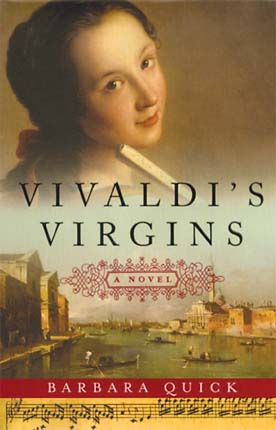Antonio Vivaldi, also known as “the Red Priest,” is regarded as one of the most greatest Baroque composer, and is widely popular even to this day. He has over 500 concertos to his name, the most famous of which are the four violin concertos, “The Four Seasons.”
Vivaldi has always been one of my favorite classical composers, so the book Vivaldi’s Virgins by Barbara Quick caught my eye at the NBS book bazaar a couple of years ago. I finally got to read it last month, because I badly needed a Q for the A-Z Challenge.
 Vivaldi’s Virgins is a historical novel that features, as it turns out, not Vivaldi primarily, but one of his most famous students, Anna Maria dal Violin, to whom he dedicated over three dozen concertos.
Vivaldi’s Virgins is a historical novel that features, as it turns out, not Vivaldi primarily, but one of his most famous students, Anna Maria dal Violin, to whom he dedicated over three dozen concertos.
Anna Maria is an orphan at the Ospedale della Pieta, a charitable institution in Venice that took in foundling girls and trained them in either cottage industries, or, if they had the talent for it, conservatory music. With her prodigious skill with the violin, Anna Maria was brought up as a figlie di coro (daughter of the choir), as the Ospedale della Pieta was famed for its choir’s musical performances, which featured an ensemble of virgin girls (whose lives are dedicated to music) playing from behind iron bars. Historically, Anna Maria dal Violin was the principal violinist of the Pieta for nearly two decades.
For most of the novel, Annina (as she is fondly called) is on the verge of young womanhood, attempting to come to terms with her identity as she yearns to discover her true parentage. The novel is part epistolary, as she writes letters to a mother she has never known, revealing her innermost thoughts and longings. She is also struggling with the strict life of discipline at the Pieta, as the more worldly girls in the Ospedale open her eyes to the pleasures of the outside world.
I love reading historical novels (especially those with an artistic leaning) and anything to do with Venice, but while this novel was sufficiently readable, I didn’t enjoy it quite as much as I expected.
I felt something was amiss with the voice of Annina; it didn’t come off quite sincere to me. Instead of the voice of a young girl in Baroque Venice, the voice was of a modern day narrator trying to sound like a young girl in Baroque Venice, which isn’t quite the same.
I also felt shortchanged by what promised to be a sensual novel — I’ve read a lot of novels set in Venice (it really is one of my favorite settings!) and I couldn’t get the feel of the city, none of the bustling canals, the labyrinthine streets, or the bejeweled aristocracy. Perhaps it’s because the protagonist is somewhat removed from Venetian society in the stifling confines of the Pieta, but even that wasn’t really depicted all that vividly. Wanting to get more out of the novel, I brought out the mood music — lucky the book is tied in with music! — and when I played some Vivaldi concertos, I was able to enjoy the novel better.
The plot moves along at the satisfactory pace, though, and we do see some growth in the character of Annina, although ultimately, the book just wasn’t memorable enough for me.
***
Vivaldi’s Virgins, hardcover with dust jacket, 3/5 stars
Book #186 for 2010
Q for the A-Z Challenge
cover photo courtesy of sxc.hu
[amazonify]::omakase::300:250[/amazonify]



Blooey, I read the same book for my Q author, and agree with you completely. I read Marina Fiorato’s The Glassblower of Murano afterwards, that provided a much better “picture” of Venice in that time period! Likewise with Sarah Dunant’s In the Company of the Courtesan, though for some reason Dunant’s writing really doesn’t do it for me.
Oh, I have the Fiorato, will try that soon.
Donna Jo Napoli’s Daughter of Venice is one of the best Venetian novels I’ve read. Cornelia Funke’s The Thief Lord is awesome too :)